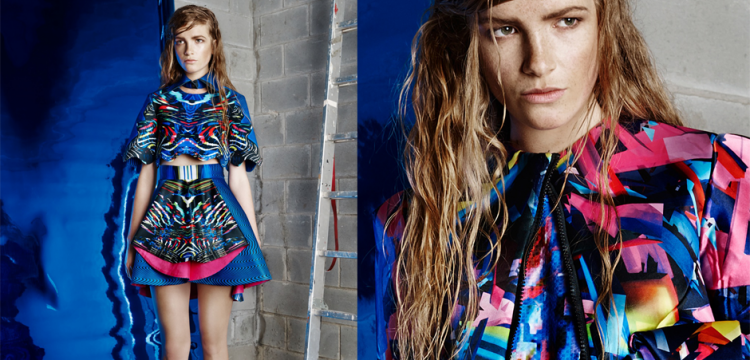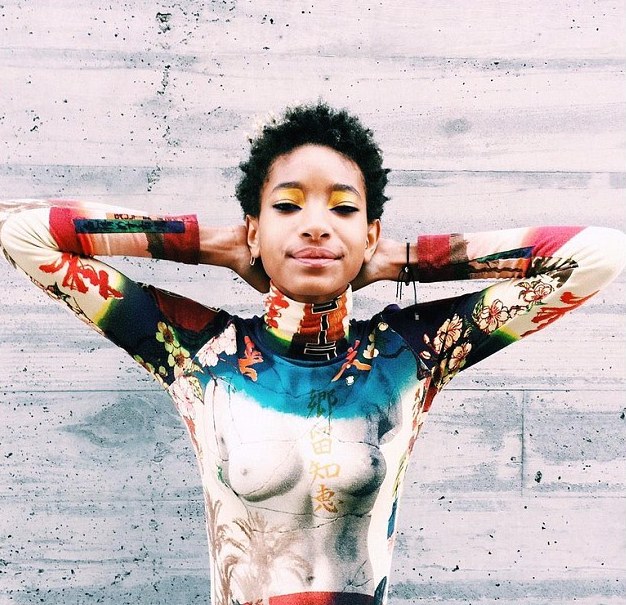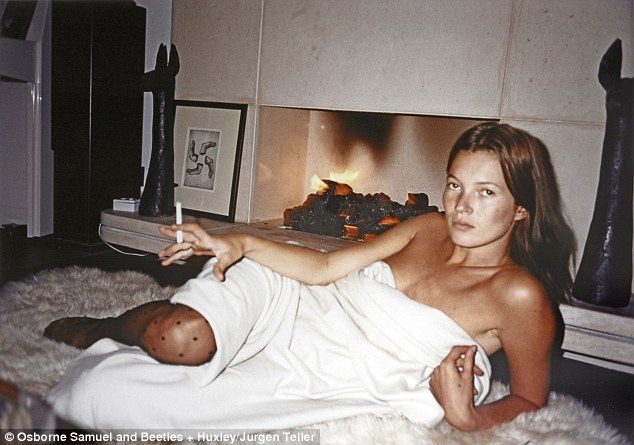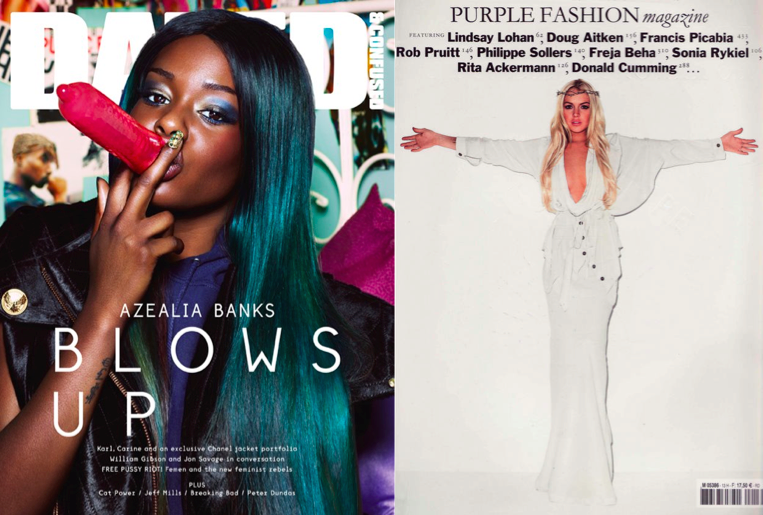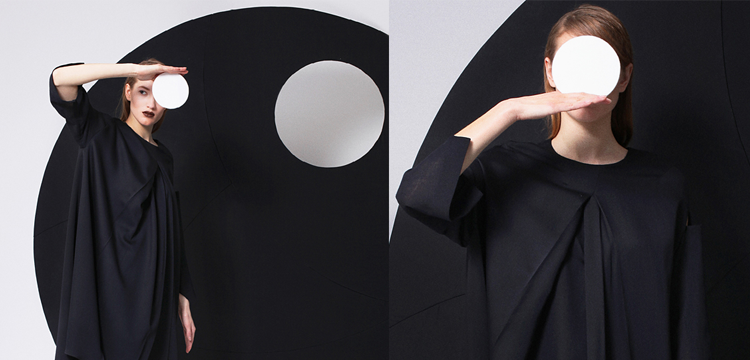Natalia was born in small town in the middle of Siberia in the late eighties, where she helped her mother sew her family’s clothes, and created her first designs at the age of eleven.

The designer tells us the story behind her clothes, which enmesh her background as a graphic designer and her love of technology, with what she describes as her ability to “see the potential in any material”…
How did you get into fashion?
I guess I was born to do it. Since I was a child I had passion to create. My mother was a dressmaker and we always had this strong connection about clothing. We used to sit through nights together and sew things from leftover fabrics, some of them from the Soviet Union. I think this experience taught me to see the potential in any material.
I started photography and retouching, which pushed me forward in learning more about graphics and illustration. I worked as a graphic designer and after seven years I realised that my true path is fashion. No digital work can compare with the feeling of a tangible garment that you made.
Where are you from?
My family moved to Yakutia in the 1980s to earn money, and that’s where I was born in 1987. It was a small town in the middle of Siberia. We lived in a deserted trailer for years, until we moved to an apartment, and had a really simple life. In 1997 we packed up everything and travelled 8,000 kilometres to Saint Petersburg.
It was fascinating to see a cultural centre of Russia with amazing architecture and atmosphere. Only now I am starting to appreciate my roots, and it gives me a lot of inspiration. It was a very specific moment in Russia, something that is hard to describe to a European person. We are very different, children of the post-Soviet era.

How did you define your particular style or approach to fashion?
I guess I see myself more as an artist, then a fashion designer. At least, I want to believe I am. Of course, I am influenced by trends and cultural vibrations, but usually I get my designs as a flash, as a whole image. It comes in a second, but then you spend days and weeks to realise it.
My job is to be the filter between my imaginary parallel world and reality; that’s why I put my main effort in developing my artisan skills. I love technologies and I am a bit of a computer nerd. It helps me a lot, because I blend images, 3D work, photographs and illustrations into my garment patterns.
What has influenced your approach?
I was very touched by The Communist Manifesto by Karl Marx. It opened my mind and gave me another perspective on reality. I am against the current system of money; the fashion industry is build on fake idols and I hope that I will be able to make an impact to change that.
Trends and mass-market companies limit the possibilities for young designers to reach people, because we can’t compete with their prices and speed. People should change their behavioural patterns about clothing, and invest in quality and emotional value, instead of cheap clones of real garments. Maybe I have utopian ideas, but that is what I stand for.
What is the problem with fashion today?
I think fashion itself is a problem. It is too fast, too corrupted and aggressive. I love clothing and personal identification, I love construction, logic, textures and colours, but I don’t like the environment of the fashion industry, which puts us under the rules of capitalism. When the richest people hire millions of people to work for low salaries eight hours a day and then spend their money on products made by the same companies, isn’t it just another version of slavery?

What does an independent designer offer to the market?
The possibilities are melting like ice, when corporations are finding their way into most of the market. The situation is getting even worse, and, for example, a major company with over 100,000 employees will share only 7% of the income with 80% of its workers. Designers, pattern makers and dressmakers are usually among this number. The people who actually make things get much less wealth than the people who play with numbers and sales strategies.
Do you have any other creative pursuits?
I am curious about everything. Life has so many different angles and I love to discover. Visual art is the most interesting for me. Photography, motion design, packaging, product design, animation… I have learned many things by myself through books and tutorials. It was very difficult to do anything other than the final thesis at the institute, but I always need to challenge myself with something new.
What makes fast fashion brands so powerful, what are your thoughts?
Obviously, money and slavery. Designers in these companies usually have to copy something from the catwalk, with no creative freedom. Later, the same design will be produced in millions of copies, widely advertised and sold in thousands of stores worldwide.
Mass-market brands offer around 40 collections per year. Most people have no idea that different brands belong to one corporation. H&M, COS, & Other Stories, Monki, Cheap Monday and Weekday belong to one corporation. Even when you think that you are supporting smaller brands, your money in fact lands in one huge basket. It is a very smart strategy to capture all types of customers.
What is the style of the city you live in?
For the past three years I have lived in Barcelona. I don’t know any other city that comfortable and welcoming. Most people here are really relaxed and open-minded, they live simple and free lives; they wear hippie pants and washed out t-shirts. I can’t say that Spanish fashion and street style inspires my designs, but it definitely influences my own wardrobe!
It seems like every city has a fashion award these days, do you think they are still relevant?
Any award is relevant, especially for young designers. I am really excited that my collection will be shown in the ModaFAD fashion show, a competition among fashion graduates in Spain that gives a good push to emerging talents. Participation in these kind of events is really important for young designers, there is no question about that.
Do you feel that school you study at dictates your style?
I am an introvert and usually I am not easily influenced. I recently graduated from IED Barcelona’s BA course. I think they had a lot of trouble with me, because I never followed rules and advice if I saw it differently. My independence is the core of my creative process and it was hard for teachers to alter my personal view. I am stubborn. I think, style wise, the students were all growing together, but were still able to develop personal taste – this is a success for the institute.
What first drew you to graphic design? And how did you make the transition from graphic design to fashion?
I never decided to be a graphic designer. When I finished school I was misfit in the Russian system of education, I didn’t go to university and instead I begged my parents to buy me a camera. I was 17 when I got my first job in a photo laboratory in Saint Petersburg. Basically I was retouching amateur family photos for 12 hours a day. Later I started to do graphic design and moved to Moscow. I learned all the programs from pdf books I downloaded from the internet.
I had huge motivation and basically studied English in one year and applied for a scholarship to IED Barcelona. The chance to move to Barcelona to study fashion was the best change that could have happened in my life. My background in graphic design helped me to build a very strong personal style.
What kind of support have you received as a young designer? And is your story typical of many Russian fashion designers?
I participated in a contest and had a scholarship for my studies at IED Barcelona, but it didn’t cover all my expenses. For these three years, I still continued to work as a freelancer to be able to pay my rent and for materials for projects. It is very expensive to study fashion, because school provide only part of the tools you need. My mother helped me a lot. I am very thankful for all the support I got. I hope that people believe in me as much as I do.
Design in general is a new thing for Russia. Most institutes provide good technical skills, and fashion design is a lot of experimenting and inventing. Russian teachers came from the Soviet school, when there were pattern and dressmakers instead of fashion designers. But there are still many new talents from Russia, and they all have different stories. My story has just begun, so we will see.
Your designs are very technological. But does a sense of history, of your country’s past or your own personal past, inform them too?
Definitely, yes. I believe that we can’t create from zero. All our life we observe and save information that comes constantly from different sources. When you design, it is impossible to avoid your past influence, because your ideas are a merge of the information that you saved. I am always trying to learn more from different areas, I read books, I try to be socially active and travel as much as I can. Fashion design is just a way to express your creative mind.


